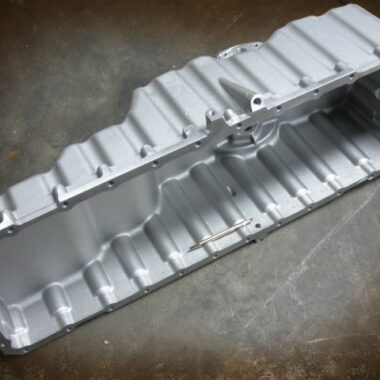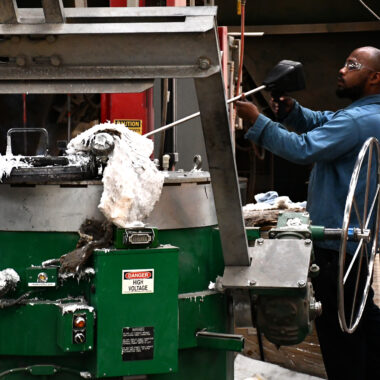Development Let Loose: Innovations About Aluminum Casting
Development Let Loose: Innovations About Aluminum Casting
Blog Article
Unlocking the Possible of Aluminum Casting: Proven Strategies for Success
Aluminum casting has long been identified for its adaptability and widespread applications throughout different industries. Join us as we explore the crucial components that can thrust aluminum casting towards unparalleled success in today's affordable market landscape.
Benefits of Light Weight Aluminum Casting
One of the key advantages of light weight aluminum spreading is its light-weight nature, which adds to fuel performance in industries such as automobile and aerospace. Furthermore, light weight aluminum is highly flexible, allowing for intricate and complex forms to be conveniently created with spreading processes.
Moreover, light weight aluminum casting provides excellent deterioration resistance, making it optimal for applications where exposure to severe environments is a problem. The product likewise displays good thermal conductivity, which is useful for industries needing warmth dissipation, such as electronic devices (about aluminum casting). Light weight aluminum is fully recyclable, straightening with the growing emphasis on sustainable practices in modern production.
Layout Considerations for Casting
When considering casting style, precise focus to detail is extremely important to guarantee the effective manufacturing of top quality parts. The style stage plays a crucial duty in the total success of an aluminum spreading project. One essential consideration is the selection of ideal geometries and attributes that help with the spreading procedure. Developers need to consider aspects such as draft angles, fillets, and wall density to ensure appropriate steel flow and solidification throughout casting.
Moreover, factors to consider associated to parting lines, gating systems, and risers are important to prevent issues like porosity and contraction. It is important to optimize the layout for efficient material usage and reduce post-processing requirements. Simulations and prototyping can be valuable tools in evaluating and refining the spreading style before full-blown manufacturing.
Collaboration in between design designers, factories, and producers is important to deal with any kind of possible difficulties early in the style phase. By including these considerations into the spreading style process, manufacturers can enhance product top quality, reduce prices, and inevitably unlock the complete capacity of aluminum spreading.
Enhancing Casting Effectiveness
When intending to boost casting effectiveness in aluminum spreading tasks,Creating with a focus on enhancing material circulation and minimizing problems is essential. To achieve this, using simulation software program can help in recognizing prospective problems prior to the casting procedure starts. By mimicing the circulation of molten light weight aluminum, developers can readjust gating and riser styles to ensure correct filling and solidification, eventually minimizing the incident of issues such as porosity or shrinking.
Moreover, carrying out appropriate warm therapy procedures can improve the overall casting performance. Heat therapy can assist enhance the mechanical properties of continue reading this the light weight aluminum casting, guaranteeing that the last component satisfies the needed specifications. Additionally, utilizing automation and robotics in the casting process can simplify production, reduce manual labor, and boost general efficiency.
In addition, constant monitoring and quality assurance during the casting process are essential for recognizing any kind of discrepancies and making certain that the end products meet the desired requirements. By executing these strategies, producers can enhance casting effectiveness, enhance item high quality, and ultimately accomplish better success in light weight aluminum casting projects.
Quality Assurance in Aluminum Spreading

Reliable high quality control methods play an essential role in ensuring the precision and integrity of aluminum spreading procedures. Quality control actions in aluminum spreading include a range of tasks intended at upholding particular standards and determining deviations that can compromise the final item.
Along with procedure control, quality control in light weight aluminum spreading involves rigorous screening and assessment treatments at different phases of manufacturing. Non-destructive testing methods like ultrasonic testing and X-ray evaluation aid spot internal issues without jeopardizing the honesty of the actors parts. Aesthetic evaluations, dimensional measurements, and mechanical testing further ensure that the cast parts fulfill the needed specifications and efficiency standards. By applying durable quality assurance practices, light weight aluminum casting facilities can supply products that fulfill client expectations for reliability, efficiency, and quality.
Taking Full Advantage Of Profitability
To attain optimum financial performance, an extensive technique for making the most of productivity within light weight aluminum spreading operations must be meticulously developed and implemented. One key facet of taking full advantage of earnings in light weight aluminum spreading is optimizing manufacturing efficiency. This includes streamlining processes, lowering waste, and minimizing downtime to ensure that sources are made use of effectively. Applying lean manufacturing concepts can assist recognize areas for enhancement and enhance overall functional effectiveness. this article

In addition, branching out item offerings and exploring new markets can assist expand earnings streams. Comprehending client requirements and market fads can guide calculated decisions to take advantage of arising chances. Investing in r & d to introduce products or procedures can also drive success via differentiation and client satisfaction.
Conclusion
In final thought, light weight aluminum casting uses various benefits in terms of style sturdiness, adaptability, and cost-effectiveness. By carefully considering design considerations, boosting casting performance, carrying out quality assurance measures, and making best use of earnings, producers can unlock the complete possibility of light weight aluminum spreading. This reputable and versatile procedure has verified to be an effective choice for a vast array of industrial applications.
In addition, light weight aluminum is extremely malleable, allowing for complex and intricate forms to be easily generated with casting procedures.Efficient anonymous top quality control practices play an essential function in ensuring the accuracy and dependability of light weight aluminum spreading processes.In addition to process control, quality control in light weight aluminum casting entails extensive screening and evaluation treatments at various phases of manufacturing. By applying durable quality control practices, aluminum casting facilities can deliver items that fulfill customer expectations for dependability, performance, and high quality.
By very carefully taking into consideration style factors to consider, boosting casting effectiveness, carrying out top quality control actions, and maximizing success, producers can open the complete capacity of light weight aluminum casting.
Report this page